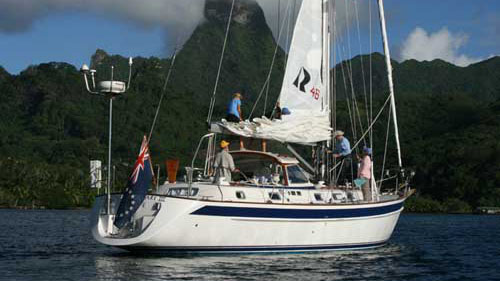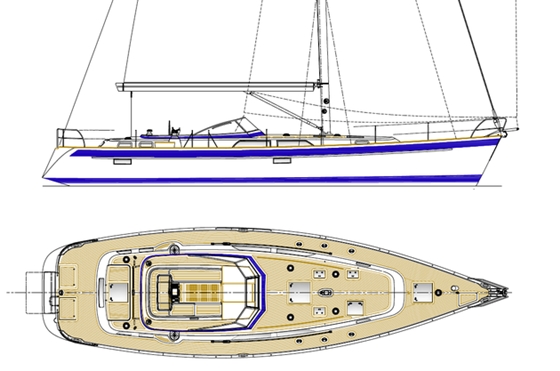Perry Design Review: Hallberg-Rassy 46
Another fine, well-mannered cruiser off the board of German Frers
Hallberg-Rassy builds some of the world's finest production cruising yachts. The new 46 is the design work of German Frers. It's a potent combination that has produced a very interesting boat. With a D/L of 260, the H-R is right in the middle of medium-displacement cruising boats. The brochure doesn't list DWL, so I had to make an estimate based upon guessing the length of overhangs; and I think I'm quite close. The brochure gives "max sailing waterline" length, but according to whom, according to what? I need a static waterline length so I can keep the ratios apples to apples. I am 6 feet 2 inches tall, but my maximum effective height to weather is 6 feet 5 inches.
With a D/L of 260, the H-R is right in the middle of medium-displacement cruising boats. The brochure doesn't list DWL, so I had to make an estimate based upon guessing the length of overhangs; and I think I'm quite close. The brochure gives "max sailing waterline" length, but according to whom, according to what? I need a static waterline length so I can keep the ratios apples to apples. I am 6 feet 2 inches tall, but my maximum effective height to weather is 6 feet 5 inches.
The underwater profile shows a partial skeg aft to help get a third bearing in the rudder system. The more I'm around skegs, the less I like them. This style of rudder installation does allow a little balance to the blade to help with helm pressure. Note the bustlelike distension of the canoe body just aft of the keel fin and fairing into the half skeg. The keel has all the lead on the bottom half of the fin. A wing-type keel gives a draft of 6 feet 2 inches and keeps the VCG of the ballast quite low.
Three interior layouts are offered on the Hallberg-Rassy 46. Galley and main cabin remain the same throughout the three versions, with settee options offered to starboard. The biggest differences are in the berth arrangements. Layout A is the most conventional and has the owner aft, while the forward accommodations are mirror-image staterooms that share a forward centerline head. Layout B moves the forward head aft to the main bulkhead and includes a shower stall. Layout C has a bigger head at the main bulkhead but forgoes the privacy of the small stateroom on the port side in place of an exposed crew berth. Aft you have the choice of a centerline double berth or a double to starboard with single berth to port. Layout A seems to make the most sense.
Cruisers will appreciate the large engine room. This engine and machinery space is accessible through either the companionway below or a seat hatch in the cockpit. This way, major work can go on in the engine room without disturbing life in the boat. The auxiliary for this design is a 95-horsepower Volvo Penta TMD 31 driving a fixed three-blade propeller. The angle on the shaft is 14.5 degrees. (Note: We are in an age where high-powered auxiliaries are the norm.)
The 46 is conservatively rigged with fore and aft lowers and double spreaders. The SA/D is approximately 15.83. That is well on the low side of SA/Ds today. The good news is that you won't even have to consider reefing until the apparent wind exceeds 22 knots.
Hallberg-Rassy designs are always good-looking. The company builds very handsome windshields and hardtops. The 46 has a nice spring to the sheer and its freeboard is in proportion to its length. This would make a safe and well-mannered offshore cruising yacht.
Another fine, well-mannered cruiser off the board of German Frers.
Boat Specifications
| LOA | 48'9"; |
| LWL | 43'9"; |
| Beam | 14'4"; |
| Draft | 6'2"; |
| Displacement | 35,264 lbs.; |
| Ballast | 14,106 lbs.; |
| Sail Area | 1,076 sq. ft.; |
| SA/D | 15.83; |
| D/L | 260; |
| L/B | 3.40; |
| Auxiliary | 95-horsepower Volvo Penta TMD 31; |
| Fuel | 172 gals.; |
| Water | 239 gals. |
 This story originally appeared in Sailing Magazine, and is republished here by permission. Subscribe to Sailing.
This story originally appeared in Sailing Magazine, and is republished here by permission. Subscribe to Sailing.
















